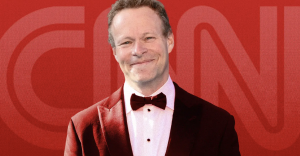The soon-to-be president of the network will face difficult decisions at the start of his run

Is there an appetite for Licht to revamp CNN’s business model for the era of cord-cutting and digital news consumption?
CNN is running out of time to diversify away from cable news, its unsustainable moneymaker. And when Chris Licht becomes president of CNN this May, he will have difficult decisions to make.
CNN’s parent company, WarnerMedia, is merging with Discovery this spring. David Zaslav, who will soon lead Warner Bros. Discovery, knows that CNN is exposed and he personally chose Licht to lead it.
Not coincidentally, Warner Bros. Discovery’s PR engine has presented Licht as a straight-shooting, no-nonsense journalist. Zaslav expects Licht to cut opinion programming and introduce more hard news.
CNN’s news programming will likely thrive under Licht’s care, but is there an appetite for him to revamp CNN’s business model for the era of cord-cutting and digital news consumption? CNN+, the organization’s forthcoming streaming channel, is his best chance.
However, CNN+ is currently set up to fail with a subscription-only revenue model. Here’s why Licht should shift CNN+ to an ad-supported revenue model and build upon CNN’s strengths through strong relationships with top advertisers.
Right medium, wrong model
Against the backdrop of war in Ukraine, CNN’s recommitment to hard news is compelling. Absent from Licht’s record, however, is the experience with new media and connected TV (CTV).
No one seems confident that people will pay for CNN+. As one CNN staffer asked, “Do people really love Jake Tapper enough to want to watch his book club?”
If Licht is committed to hard news and running a streaming business, he must rethink the subscription model (and some of CNN+’s content). CTV is growing faster than expected, with household penetration in the U.S. now 30% higher than cable TV. CNN will lose cable ad revenue—and audience—unless people can transition to CNN+ easily.
Despite how critics spin it, the decline in cable news viewership is not unique to CNN. As of 2021, Fox News, MSNBC and CNN have each seen declines in viewership. And no wonder: 79% of 18- to 29-year-olds get their news on a smartphone, computer or tablet, while only 16% use TV; 30- to 49-year-olds are nearly as digital.
Meanwhile, CTV advertising is growing by double digits every year, driven by programmatic buying and ever-better targeting. CTV ad spend is projected to reach $29.5 billion by 2024.
Given CNN’s success with ad-supported cable news, why wouldn’t CNN+ offer ad-supported news? Why leave the cable audience and advertisers stranded without a convenient way to follow CNN to CTV?
Surviving cable’s decline
Advertisers need CTV to reach cord-cutters in their prime spending years. If they can’t reach their audience at CNN+, they’ll reach it elsewhere.
To be fair, Warner Bros. Discovery might be preparing a streaming bundle in which CNN+ is just a cherry on top of HBO Max and Discovery+. In that case, though, hiring 500 more staff for CNN+ doesn’t make financial sense.
CNN has a new president—now it needs a new business model that can survive cable’s decline. The following steps might put Licht in a position to succeed.
Licht needs deputies who complement his skill set. An example would be Cheddar Inc. founder and CEO Jon Steinberg, who recently announced his departure from the live streaming financial news network. Given his experience, Steinberg could help CNN build a relationship with digital-only Gen Zs and millennials and certainly revamp CNN.com, which seems to be adrift.
Another example is Scott Rosenberg, Roku’s svp of platform business, who is set to resign this spring and would be another smart hire considering his long-time, old-school experience in the space. A veteran like Rosenberg could deliver a streaming model that produces synergies between CNN+ and CNN.com.
By surrounding himself with talent like this, Licht would not only complement his skills but also the evolving landscape of the media business model.
CNN should consider an acquisition now that cable isn’t driving growth. Maybe the better play for CNN is an acquisition in podcasting. CNN could produce star podcasts, like The Daily and Sway, to drive streaming and web traffic. In turn, the podcasting IP could fuel CNN Films, which has produced outstanding work like Navalny, Three Identical Strangers and Blackfish.
We see podcasting as a significant growth sector, with advertisers rushing to catch up with younger and devoted audiences that have been inhabiting the space in recent years.
Licht must decide whether to stick with CNN’s urban-liberal audience or expand into the heartland. Neutral news, combined with some educational and Americana programming on CNN+, might repair relations with jaded moderates. A neutral news network that can’t reach the middle will find itself without an audience.
Rooting for CNN
Under Licht, there is no doubt CNN will produce outstanding news content—as he’s done before—but his next and new challenge is transforming CNN into a digital business, where he’ll need deputies, acquisitions and content that can make the most of CNN+. With CNN’s outstanding on-the-ground coverage in Ukraine, everyone should be rooting for the network to find its stride. CNN has so much untapped potential.
Maybe we’ll see that potential in a subscription bundle with HBO Max and Discovery+. But hopefully, CNN+ will reach millions more people with an ad-supported streaming business. It just makes better sense.


